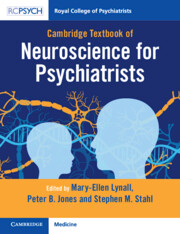Book contents
- Cambridge Textbook Of Neuroscience for Psychiatrists
- Reviews
- Cambridge Textbook of Neuroscience for Psychiatrists
- Copyright page
- Contents
- Contributors
- Introduction
- 1 Cells
- 2 Neurotransmitters and Receptors
- 3 Basic Techniques in Neuroscience
- 4 Neuroanatomy
- 5 Neural Circuits
- 6 Modulators
- 7 Genetics
- 8 Neurodevelopment and Neuroplasticity
- 8.1 The Development of Brain Structure and Function
- 8.2 Neurodevelopmental Models of Psychiatric Disorders
- 8.3 Attachment
- 8.4 Neuroplasticity
- 8.5 Intelligence and Intellectual Disability
- 9 Integrated Neurobiology of Specific Syndromes and Treatments
- 10 Neurodegeneration
- Index
- References
8.2 - Neurodevelopmental Models of Psychiatric Disorders
from 8 - Neurodevelopment and Neuroplasticity
Published online by Cambridge University Press: 08 November 2023
- Cambridge Textbook Of Neuroscience for Psychiatrists
- Reviews
- Cambridge Textbook of Neuroscience for Psychiatrists
- Copyright page
- Contents
- Contributors
- Introduction
- 1 Cells
- 2 Neurotransmitters and Receptors
- 3 Basic Techniques in Neuroscience
- 4 Neuroanatomy
- 5 Neural Circuits
- 6 Modulators
- 7 Genetics
- 8 Neurodevelopment and Neuroplasticity
- 8.1 The Development of Brain Structure and Function
- 8.2 Neurodevelopmental Models of Psychiatric Disorders
- 8.3 Attachment
- 8.4 Neuroplasticity
- 8.5 Intelligence and Intellectual Disability
- 9 Integrated Neurobiology of Specific Syndromes and Treatments
- 10 Neurodegeneration
- Index
- References
Summary
The current era of diagnostics in psychiatry is nested within the axis between categorical labels which define distinct clusters of symptoms (e.g. the Diagnostic and Statistical Manual of Mental Disorders, 5th edition (DSM-5); American Psychiatric Association, 2013) and the International Classification of Diseases, 11th edition (ICD-11; World Health Organization, 2018)), and dimensional constructs which define continuous quantitative traits (e.g. the US National Institute of Mental Health Research Domain Criteria). Unlike neurological disorders such as Alzheimer’s disease and Parkinson’s disease, there is currently no conclusive evidence of a causal mapping of biological mechanisms to clinical symptomatology nor are there reliable neuropathophysiological correlates on which to base or confirm diagnoses. Thus, the quest for biomarkers in psychiatric disorders rests on the ability to untangle the convergent (shared) and divergent (distinct) effects in these conditions at multiple levels of biological scale – from molecular-scale genetics and transcriptomics, macroscale endophenotypes derived from neuroimaging, through to observable and quantifiable behavioural, cognitive and psychological phenomena.
- Type
- Chapter
- Information
- Cambridge Textbook of Neuroscience for Psychiatrists , pp. 349 - 353Publisher: Cambridge University PressPrint publication year: 2023

